
|  |

|  |
 e-mail: khokar1960@gmail.com India's biggest annual dance conference: The Natya Kala Conference Photos courtesy: NKC January 6, 2024 The Natya Kala Conference is an annual feature of the Krishna Gana Sabha. For those outside Tamil cultural landscape (and this portal and column travels far in the virtual world) sabhas are basically registered art bodies /societies from last century that serve the cause of the arts and culture. What began as a guild is now gold in terms of land and location; power and pelf. Trustees and members are either eminent citizens or families and they are pillars of the art eco systems. They dispense patronage while creating trends. Each may have preferences and power structures, yet, most are genuine and totally devoted to the purpose it was set up for. So, the Krishna Gana Sabha (KGS) has for 40 years held the NKC (Natya Kala Conference). The current head Y Prabhu (son of R Yagnaraman who started and steered it for decades) with daughter Saashwathi are in-charge and do their duty with finesse, advised by stalwarts and icons in the field. Rama Vaidyanathan needs no introduction to Indian dance audiences worldwide. A Delhi-based Bharatanatyam dancer, she is now also a star with substance and spunk. A student of Bharatanatyam's benchmark icon Yamini Krishnamurti, Rama is now herself a benchmark in dance and NKC convenorship. This year was dedicated to 'Swarna Saroja' in memory of her mother-in-law, Saroja Vaidyanathan, a veteran Delhi based Bharatanatyam dancer guru who started the Ganesa Natyalaya, whose 50th year anniversary too was being celebrated. Says Rama: "My first conference in 2019 was Nirikshana, examining the current state of Bharatanatyam . The second one was Roots that looked at the origin and genesis of all the classical dance forms. So it was natural for me in the last and final year to look at how do we go beyond the form, and how do we explore the immense possibilities that dance offers us. So I wanted to make it futuristic, transcenDANCE!" Rama Vaidyanathan's helming of the three years of NKC is now a reference point. The bar she has set will be hard to emulate, reach or copy even. She was the convenor for last two years and this was her third, bonus year, and a curtain call from its stewardship. Some in past like Srinidhi Chidambaram too got a chance to convene for 3 years. Time alone will tell what happens next year under the new convenors Nirupama- Rajendra (Karanas and Kathak dancers of Bangalore).  Sudha Raghuraman & Meera Sreenarayanan The opening montage was strong, even if sort of transformative dark, signifying change. Meera Sreenarayanan depicted the theme of transcenDANCE while Sudha Raghuraman sang as if there was no tomorrow. Here's a voice that deserves a national honour. Both set the artistic tone for the NKC- 41. 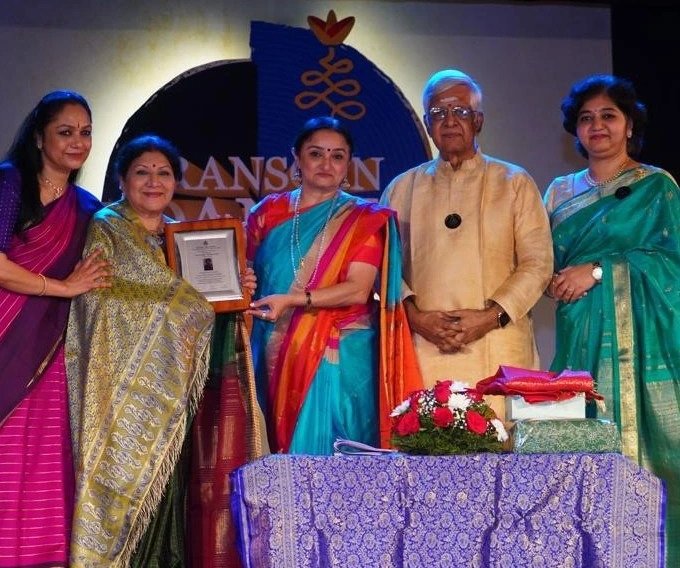 L to R: Rama Vaidyanathan, Rathna Kumar, Sandhya Purecha, Y Prabhu, Saashwathi The 41st NKC began with lots of goodwill and energy. Darling amongst USA settled dancers, Rathna Kumar was honoured with the Natya Visaradaha title of KGS and Prabhu and Saashwathi did the honours. No less than the chair of Sangeet Natak Akademi had flown in from Bombay for this. Dr. Sandhya Purecha is an active, down-to-earth and qualified head of an organisation that is held as mai-bap of dance, music and drama patronage. In her address she is clear and concise and speaks without fuss or fanfare. She made two important points: ghoda adda kyun; roti jali kyun? Loosely translated it means: why did a horse not budge an inch or run the race and why did the (Indian) bread get burnt? Answer: Pher. Change. Change is necessary for growth. What's happening in other areas need to happen in arts too, she stated. Natya is for greater purpose, not just performance. There's teaching, reaching out and mentoring. Education, social goals and more. Spiritual too. To every kriya there's vikriya too. The theme of this NKC being to transcend, SNA chair connected it to - Transformation leads to transcendance. Transcend some did but dance? Many sessions during the five days feast felt like there was more talk and less of dancing. And Rama included all concerns and contexts - it was as though no one was left out. She should now do a good book on the 3 years of her making of this mammoth feat and put up in the book stall that was a huge success this year thanks to Shubhi's Sanjay Arya, who himself sat there 5 days! He is the only dance publisher left in India, as it is a thankless job. Dancers don't read much unless they are featured in it, preferably on the cover! Printing costs have gone up 40% post Covid and so the Chinese torture continues. Sanjay was seen distributing face masks on the third day when news of death of an actor Vijaykanth came that he died of the new Covid variant. Do you think anyone cared to wear mask? Very few did. 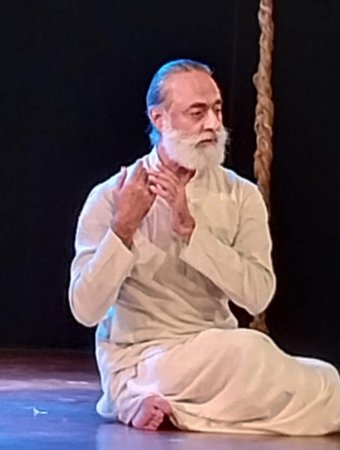 Navtej Johar Navtej Singh Johar opened the NKC- 41 with his customary composed style, bringing together a Pallavi-Padam, he said. Navtej treats dance as yoga as dance. The meeting and meshing of two was seamless. The question to be asked of him was the process. What's his process? To reach that centredness. That still point. Did yoga help his dance and if so, why was he occasionally unfocused on stage? Nevertheless, among his stated gems were: Art never comes out of body. Idea of an ideal body is dismissive to body itself! Body is Muse. When I'm dancing, I'm with the muse. My interiority is in public domain. 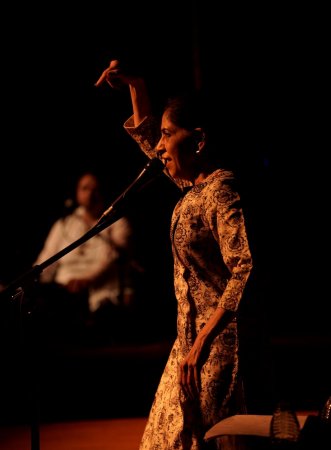 Aditi Mangaldas An icon of Kathak, Aditi Mangaldas proved what extraordinary talent can do to ordinary units of dance. Take Kathak. When one breaks down all the footwork and flourishes to base level, that's what she did. Connect and convert padhants to poetry. Effortlessly (though not without hard work of many years) she broke down simple dance grammar and technique into flowery, meaningful canvass of elements as though one was water, one air, one earth and one the sky. She started with an ode to the art historian B.N.Goswamy and showcased two paintings. She wanted to convey transcendance which to her meant transformation and spoke of her two gurus Kumudini Lakhia and Birju Maharaj. Depicting just fire as transformative - from keeping one warm to burning all to cinders - to purification she dovetailed with water as river, waterfalls, whirlpool, waves, even tsunami. Aditi is adroit at communication. She also gives filtered knowledge through dance. She took Kathak to another level. 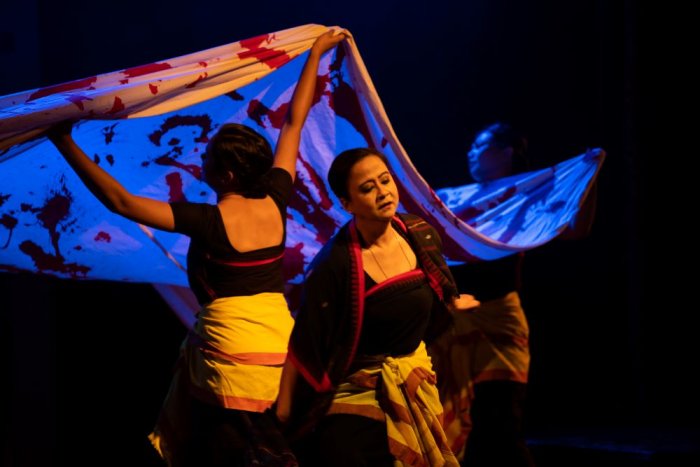 Bimbavati Devi & group in 'Footprints in Blood' The concluding session on day one was full of blood... in Manipur. For a classical dancer to take up political issue is a touchy business. Official patronage can slowly dry up and sarkari sinecures can vanish. Forget awards or rewards but one can be ostracised too. Just as her father was in Manipur then. Guru Bipin Singh was treated poorly in Manipuri dance setting for many reasons but also as he hailed from Cachar in Assam. I'm talking of 1960s when he tried to break from the moorings and mould and thus was boycotted by his own brethren and fellow travellers. He left it forever and came to Bombay to teach this style. Fortunately for him 4 rich sisters - the Jhaveris - helped him set a base in Bombay by learning from him and rest is history. Guru Bipin Singh succeeded so much that from Bombay he branched off to Calcutta and established himself there too, where after him his illustrious wife Kalavati did much for the form and now his daughter Bimbavati takes his work forward and how! Her work 'Footprints in Blood' made all sleepy members in the audience wake up and see what a tale through what a superb technique she had to tell. The production itself is a blend of three stories of suffering by Manipuris, especially women. The first story pertains to the second Nupi Lan (women's war) that occurred in 1939! OMG, that long ago. The second story details the bold Meira Paibis or torch bearers of Manipur. The third and last story is about the historic nude protest by a group of women in 2004 against rape and pillage by "protectors of state". Bimbavati used Thangta traditions and Manipuri dance with intensity rarely seen before. Hers is a production worthy of being seen in many cities wherever there's awareness for social change and women's causes. She transcended even dance. The standing ovation that followed was genuine. NKC under Rama Vaidyanathan has grown to be so inclusive that extra hours were added to by the KGS (the Sabha!), an hour in the morning and an hour and half post lunch. While in the morning all are fresh and raring to go, post lunch in Chennai's balmy climate helps induce sleep. 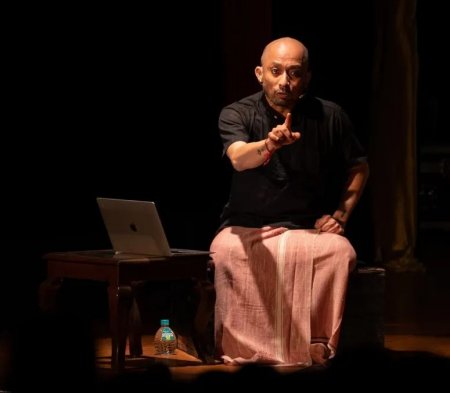 Mavin Khoo Day 2 brought early morning workshop by artivist Sangeeta Iswaran, a globe trotter. 'Beyond body, beyond form; surrendering to exhaustion' sounds like a negative title for an early morning session but Malaysian Mavin Khoo, or Australian or European by domicile now, shared his take and tale, sincerely. Mavin Khoo show-cased his concerns through 3 short snippets from films that spoke of his collaborative work with Akram Khan, the UK based trained in Kathak, star and sensation worldwide. Mavin Khoo is a deep and focused talent and his one line said it all: It is within small things that one finds God. He also emphasized on gaze. Its specificity. System of value. An honest entry point. Role as a facilitator. Express, enable, evoke. When one is clear, then only clear definitions emerge. Mavin proved that. 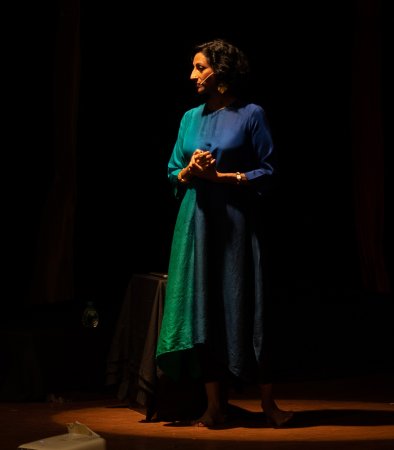 Kalpana Raghuraman The next session by Dutch artiste of "dark, Indian origin" (her words!) Kalpana Raghuraman was more of a chat show, lightly measuring racism versus voyeurism. Whenever she burst into Tamil, it sounded rushed, even aggressive, as though hidden in her being was this victim card of racism one faces abroad, while teaching or dancing an Indian classical dance form. She speaks fast and furious, with a lilt in her voice but what could be shared in ten minutes took a good half an hour. Brevity escapes most dancers and the art of editing (their speech and dance!). This happened often during the five days with more talk, less dance. 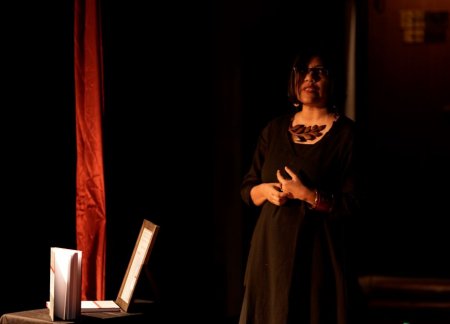 Sohini Chakraborty Next came a healer from Bengal that has suffered much, historically. First the region was important, nay, even the capital of India. The locals aped the British masters most. Then the same Brits left them partitioned! Then they suffered some more and later a still new nation was born where stood their ancestors. Sohini Chakraborty's session on culturally contextualised dance movement therapy was informative but in the end sounded like a spiel for her therapist group Sanved and the Sampoornata - the "feminist" model. Her bracelets and bangles made as much sound as did she but she got the sleepyheads going. Dance therapy of years of practical experience came through. For her, classical dance is exclusive and elitist. In any culture, medieval or modern, classical arts were never for the masses, by definition. That's because they were chamber arts, needing many years of training and development and performed for a few who understood scriptures, text, notation or scores. The 3S: Sangeet, shastras and sahitya, here. For the masses the entertainment was the gladiators then, circus later and now sports in stadium. 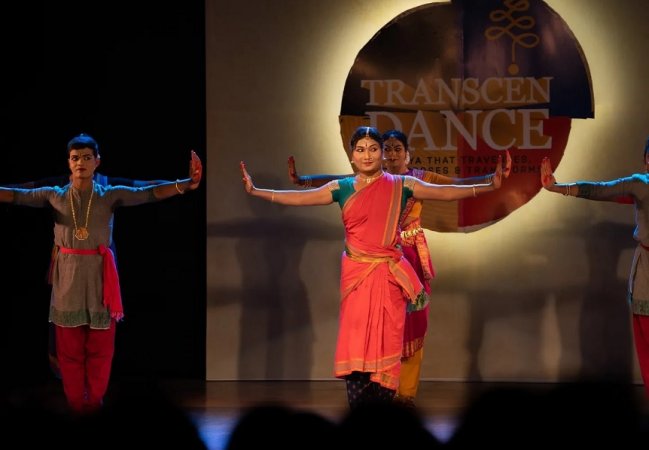 Transgender dancers Next session, was a platforming of transgenders by Shanmuga Sundaram, the ever-smiling talent of Chennai. Trained by redoubtable gurus like K.J. Sarasamma and senior Chitra Visweswaran, he brought to the fore talent Vaishnavi who is an auto-rickshaw driver. She made everyone laugh with humour and mirth. The talent told tales of how shoulders pained in delivery and how keeping legs apart in araimandi position, post sex transformation surgery didn't make it easy. All danced with joy and one could see the effect and impact of dance in their lives. It gave them a choice. Choices by Rathna Kumar was a cameo on coming out. The teacher tries to train equally but one of the students obviously had some concerns that are eating into her system. It is about choice. She loves a she and not a he; in the end she explains to her teacher who then transcends all set boundaries. The problem was Rathna Kumar on stage looks 40 when she claims she is 70+. There's that mischief under the layers and that swiftness of a brilliant mind and a well-trained body. Her performers were Sadhana and Bhavana Gollapudi. Both acquitted well. Rathna Kumar is a delight to watch and her blood group must be B positive. Like mine! 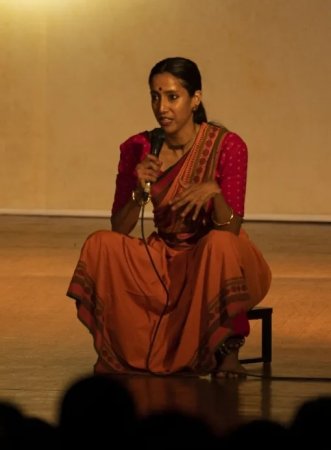 Mythili Prakash On day 3 prakash dawned via Mythili, a high octane dance talent of USA. Her topic was 'Dance as a lived experience: between the boundaries of dance and life.' While her dancing was supple and strong at the same time - the theme of Durga lending itself to that - her pronouncements in the end like what's classical? did not gel. A good example was G.Venu and his daughter Kapila the next day or Sharmila Biswas's Orissi offering to know what's really classical. It has become fashionable of late to question everything. 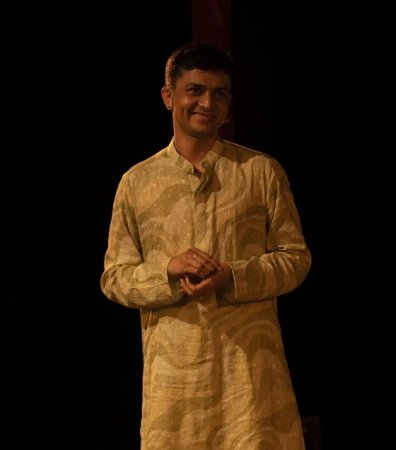 Masoom Parmar 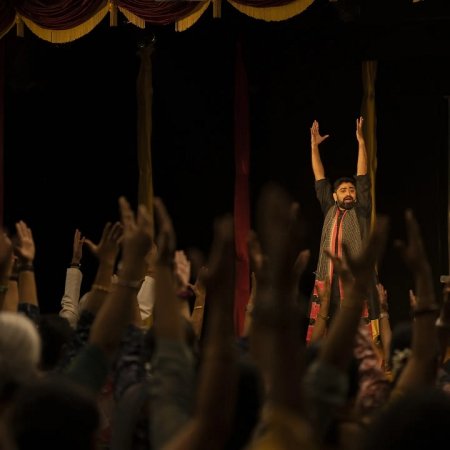 Hrishikesh Pawar Masoom Parmar next was a sweet story of much ado about nothing! A beautifully shot film but dance? While NKC afforded everyone a platform, the art content and connect was more verbal than visual or actual. Saying that his foundation was faulty or that his teachers were not good made for good stories and it also means he - the student – wasn't able either. India Foundation for the Arts funded this film and it was a work of art. Hrishikesh Pawar of Pune used the Sohini model of make-the-audience dance and got good footage of all of us dancing to his tunes! He has finally found a niche in the dance field having tried Kathak and contemporary. Parkinsons' is involuntary movement we all know and he shared that it is of four categories: rigidity, tremor, stiffness and gaze or balance. He kept the audience engaged with documented work that was very moving. 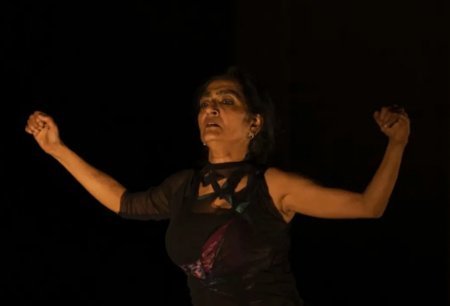 Dr. Ananya Chatterjea Dr. Ananya Chatterjea is an academician-dancer-choreographer and her concerns and angst manifests in various ways on stage. The works are deep and dark, sometimes. Her concerns led her to focus on social justice choreography under the umbrella 'In Dissent and Solidarity.' Narratives are long and what can be said in five minutes, some take 15! Dancers or those with an academic bent blur the lines between the two on stage, often. The next offering was by Mythili Kumar's group with her 'California Wild Fire' headed by Rasika Kumar in her mother's absence. Ramya Harishankar’s ‘Bhumika - a mother's lament’ provided a soothing relief with mostly well-made films on herself. 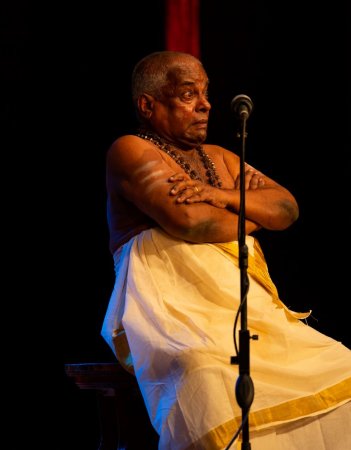 G Venu 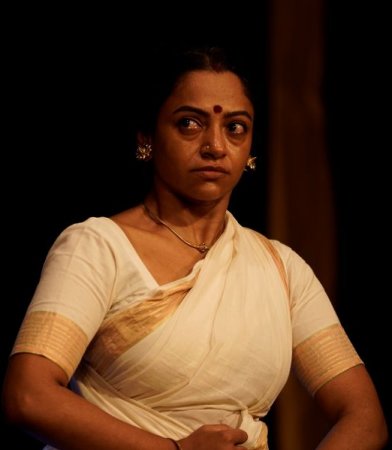 Kapila Venu Zia Nath was billed for the workshop on the fourth day. It was left to G.Venu and daughter Kapila the next morning in 'Stillness in fluidity' to show what classical art and craft is all about. The roots are so strong that by definition Bharatanatyam or Koodiyattam forms are eternal. No matter what outside influences or liberties taken, the forms continue. Koodiyattam is a sit-down affair with hardly any stage covering bodily movements. Or, it has minimal, unlike in other forms. So the energies can focus on face or certain limbs alone. It is the only surviving Sanskrit theatre. G .Venu learnt from various gurus and attached himself to successful ones in each generation: Guru Gopinath first and then Guru Ammanur Chakyar at Irinjalakuda. He served him much and now serves the theatre field as expert on navarasa sadhana, a module he has devised purely on the importance of breathing. He showed how that effected, enhanced and helped in portrayal of Raudram, Bhibhatsam, Sringara......His was the most accessible academic talk in the entire five days and best explained with simple words. He and Kapila deserved the standing ovation they got. The moot question no one asked was: how many can learn and earn from this form, unless native of the place and system? Bharatanatyam, Kathak, Odissi, Chhau, even Kathakali and Mohiniattam anyone can but the eco system of Koodiyattam is very specific. I recall Richmond Farley and Martha Ashton in 1970s did so and so have a few other foreigners but they learnt for academics, not performance. 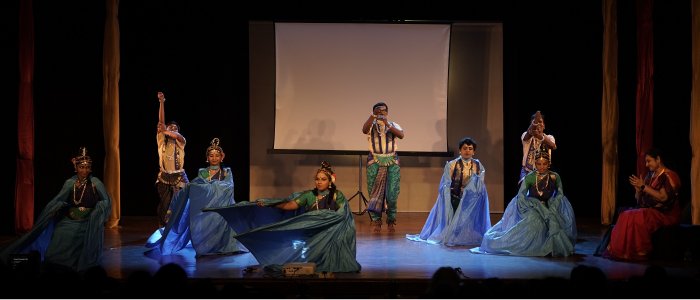 Dr.Ambika Kameshwar & disciples Dr.Ambika Kameshwar's session was pure innocent one of dance by the differently abled. To see an assembly of smiling faces and bodies that were as-is-where-is-basis, dress up and showcase their art and ability gave joy. Ambika speaks clearly and her winsome personality on stage tells her inner joy doing this work with the disabled. Each one on stage was simply adorable and this is not a sympathy vote or note, it was their art. One section could not see well but we saw what grace and coordination they danced with. 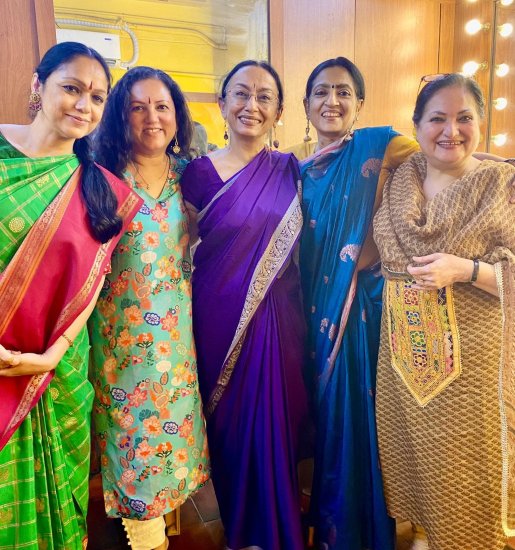 Rama Vaidyanathan, Priya Srinivasan, Urmimala Sarkar, Ananya Chatterjea, Arshiya Sethi 'New Writings and Practices on Dance' was moderated by Dr.Arshiya Sethi who also has been a writer, festival organiser, arts administrator, facilitator and of late, an academic. Her ability to present new wine in old bottle is amazing! Her co-panelists were Dr.Urmimala Sarkar of JNU, a well-known academician; Dr.Priya Srinivasan, a researcher-dancer based in Australia and USA based dancer-thinker Dr.Ananya Chatterjea. All are established in their own domain and tried to elaborate their pet causes and concerns. Ananya said, "(as dancers/choreographers) contemporary we all are; just not white contemporary!" Her work with off-beat countries which are not on anyone's bucket list shows her passion for and commitment to the cause of dance and feminism. Dr. Urmimala Sarkar stated that all dance was originally written or cast in stone (sculptures or iconography), that's how it has come down to us (through text) and for some it was proof enough. Dr.Priya spoke on racism. That their idea of new writings also means a portal of feminist writings - SADI - got announced. The session was rather jumpy with no centre. In a 5 day intensive, with each passing day the absorption rate lessens. Senior arts writer of Chennai, V.R Devika questioned in the end, "Now we have to listen to new definitions from NRIs (coming from abroad). Before it was the white man we had to listen to." Her point was: All the speakers lived or worked abroad (2 of the 4, mostly) and it is easy to pontificate but difficult to live here and do in local conditions. None on the panel had an answer. Local conditions with high art was the next offering, post lunch - called Manodarpan. Sharmila Biswas is that quiet senior, sincere talent of Odissi from Bengal. Always dancing to her own tunes, she never repeats an idea; in 30 years one has seen her grow from strength to strength. She has researched and used the tantric traditions, the mardala traditions and now Natyashastra to prove vachika and angika aspects through Odissi to bring closer to spirituality. If one production in the five day NKC left one marvel at use of stage and props and shifts and patterns, it was this. Spellbinding it was. It was also solid in content, strong in action and substance full in style. Never once was the language or grammar of Orissi sacrificed or diluted. Each of the dancers was well trained and performed with full spirit. Sharmila got a standing ovation and one can see why.  Divya Devaguptapu On the final day, the feats grew heavier with Nimmy Raphel in morning workshop and Divya Prabhandam! Yes, her offering from Kshetrayya as away from a pining nayika was most reflective, balanced, polished and aptly researched. Divya Devaguptapu was an epitome of grace, beauty and most soothing Bharatanatyam seen in recent times. There was no need to impress, leave alone rush. There was no need to filigree and the musicians understood this too. She made the morning deep. As the next session was by yours truly I can only say those who saw can speak better as viewers. I tried to cover 100 years of dance milestones in a ten minutes film. As legatee of legacy of Prof. Mohan and Saroja Khokar, it was an attempt to show the man's lifetime work as it was also his hundredth birthday that day. 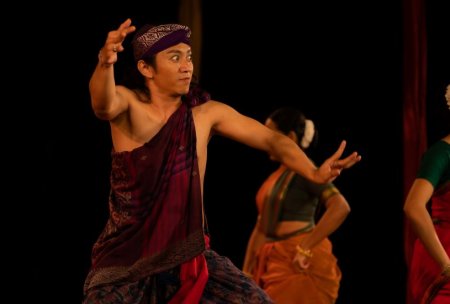 Balinese dancer 'Natyarambha to Mungkah Lawang' brought Singapore based organiser-dancer Aravinth Kumarasamy with Balinese dancer Dr. I Wayan Dibia, a Padamshri awardee to boot, no less. Lata Pada was part of the trio, in absentia. The idea was to show the opening act in two traditions - Bharatanatyam and Balinese - and to show commonalities while maintaining distinct features. Say the shoulder movement or the hands. The session showed how forms have crossed oceans and influenced each other... TranscenDANCE! 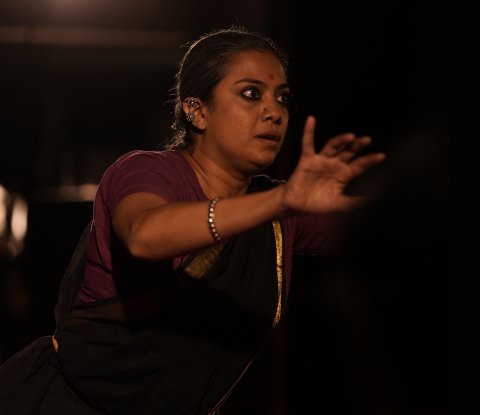 Shashwati Garai Ghosh 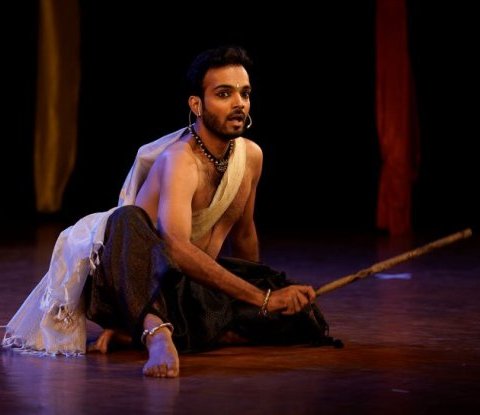 Bhavajan Kumar By telling stories one can reach out too. Rajika Puri has an active dance theatre presence and often comperes Indian dance shows in New York City. She was brought to this by icon Indrani Rahman and so she started her sutradhar act some decades ago. She knew some mythology and traditional lores as she had learnt Orissi from Debu da (guru Deba Prasad Das, Indrani's guru), and Bharatanatyam from Sikkil Ramaswamy. She teamed with Shruti Gopal, a disciple of late guru Padmini Ramachandran (seen as dance teacher in Pondi in The Life of Pi fame, in end) and currently from Mavin Khoo. Shashwati Garai Ghosh is an established dancer who learnt from Sharmila Biswas. Bhavajan Kumar of Canada formed part of the team and all acquitted themselves well.  Sonal Mansingh and group The finale by diva Dr. Sonal Mansingh with a dance-drama feature on Buddha was not what the audiences had expected when the icon of dance was at hand. Most wanted to hear her on stage in her Harikatha rendition. She does so with aplomb and gusto. She is a natural and excellent communicator. The smiling Buddha was sweet until he did the disappearing act from the palace, leaving a wife distraught. Sonal Mansingh has long spoken for women causes off stage and on and this production - idea of women in Buddhism - was just that. In the concluding session, Rama Vaidyanathan received a thunderous applause and her team was thanked too. They worked many days before even the actual 5 day feast had unfolded. Akhila Krishnamurthy's Aalap ably handled logistics and PR well and is a professional set up for event management, festival curation and book launches. The Krishna Gana Sabha also pulled out all stops and let the premises have a festive air by allowing stalls to be put of books and spice and all things nice! NKC- 41 was a feast and feat like never before. Really. Rama stands tall. 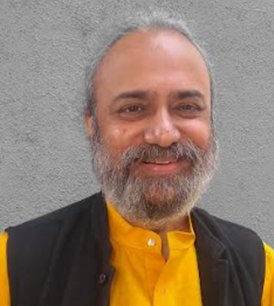 Critic, connoisseur, historian, author, artivist, archivist, administrator and more - editor, columnist and mentor Ashish Khokar remains true to his muse. More on attendance-india.com Post your comments Please provide your name and email id when you use the Anonymous/blog profile to post a comment. All appropriate comments posted with name and email id in the blog will also be featured in the site. |